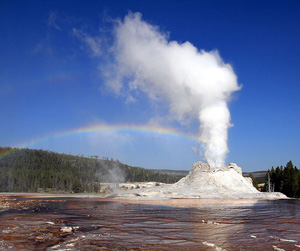Springs and Geysers

Most of the time, we do not even notice when groundwater is discharged to the surface because it happens under streams. Occasionally, it bubbles up to the surface at a natural spring. At some other places on Earth, there are spectacular manifestations of groundwater called thermal springs and geysers. These are areas where scalding water and steam commonly erupt high into the air.
Geysers and thermal springs are usually caused by groundwater that has migrated through areas of hot, but not molten, igneous rocks. In areas of recent igneous activity, rocks associated with old magma chambers can remain hot for hundreds of thousands of years. If groundwater flows through these areas, it is heated. When it is discharged to the surface, it produces thermal springs and geysers. A thermal spring is simply a spring that is filled with heated water. A geyser is a thermal spring that intermittently erupts jets of hot water and steam.
Geysers develop when groundwater is under pressure in cracks or rock pores, and that pressure builds to the point that the temperature and pressure balance converts the water to steam. They are rare and are found in only a few places on Earth, generally near active volcano areas. More than half of the world’s geysers are found in Yellowstone National Park in the U.S. Geysers are also common in Iceland and Australia.